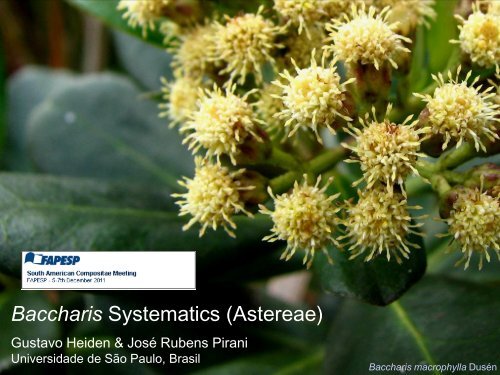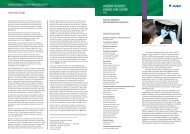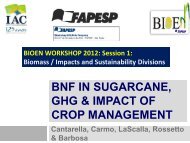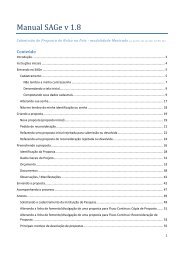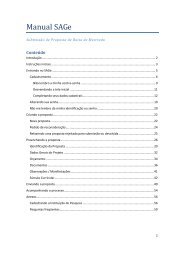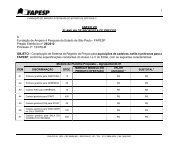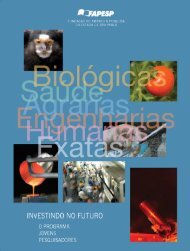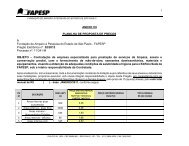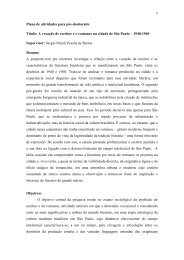Baccharis Systematics (Astereae) - Fapesp
Baccharis Systematics (Astereae) - Fapesp
Baccharis Systematics (Astereae) - Fapesp
Create successful ePaper yourself
Turn your PDF publications into a flip-book with our unique Google optimized e-Paper software.
<strong>Baccharis</strong> <strong>Systematics</strong> (<strong>Astereae</strong>)<br />
Gustavo Heiden & José Rubens Pirani<br />
Universidade de São Paulo, Brasil<br />
<strong>Baccharis</strong> macrophylla Dusén
Compositae: 12 subfamilies, more than 40 tribes (Funk et al. 2009, Funk & Bonifacino 2010)<br />
Subfamily Asteroideae<br />
Tribe <strong>Astereae</strong><br />
Monophyletic<br />
(Brouillet et al., 2009; Funk et al., 2005;<br />
Goertzen et al., 2003; Jansen et al., 1991; Kim<br />
et al., 1992; Kim & Jansen, 1995; Lane et al.,<br />
1996; Noyes & Rieseberg, 1999; Panero &<br />
Funk, 2002, 2008; Zhang & Bremer, 1993)
<strong>Astereae</strong>: 18 subtribes, 222 genera, ~3.100 spp. (Brouillet et al., 2009; Nesom & Robinson, 2006)<br />
31 genera and ~740 spp. in South America<br />
Ecaudate and ecalcarate anther bases<br />
Two distinct marginal stigmatic lines and deltate<br />
to triangular or lanceolate style appendages,<br />
glabrous adaxially and with sweeping hairs<br />
abaxially
<strong>Astereae</strong> in Brazil: 8 subtribes, 16 genera, ~220 spp. (120 endemic)<br />
Baccharidinae<br />
<strong>Baccharis</strong> 160 spp.<br />
Machaerantherinae<br />
Grindelia 7 spp.<br />
Asteropsis 1 sp.<br />
Conyzinae<br />
Apopyros 2 spp.<br />
Podocominae<br />
Inulopsis 4 spp.<br />
A.A.Schneider<br />
Conyza 12 spp.<br />
Microgyne 1 sp.<br />
Hysterionica 3 spp.<br />
Podocoma 6 spp.<br />
Leptostelma 4 spp.<br />
Neja 3 spp.<br />
Sommerfeltia 1 sp.<br />
Solidaginae<br />
Solidago 1 sp.<br />
Chrysopsidinae<br />
Noticastrum 8 spp.<br />
Grangeinae<br />
Egletes 1 sp.<br />
Symphyotrichinae<br />
Symphyotrichum 5 spp.<br />
www.cnip.org.br
<strong>Astereae</strong>: Baccharidinae<br />
Variability in the sexual systems<br />
Homogamous or heterogamous capitula, not in the same plant<br />
Archibaccharis Heering<br />
32 spp.<br />
Archibaccharis schiedeana (Benth.) J. Jacks<br />
Monoecious<br />
Flowers hermaphrodite and unisexual<br />
Cypselae 2-ribbed, flattened<br />
www.sbs.utexas.edu<br />
<strong>Baccharis</strong> L.<br />
~400 spp.<br />
Dioecious<br />
Flowers unisexual<br />
Cypselae >5-ribbed, cylindrical<br />
<strong>Baccharis</strong> leucocephala Dusén
<strong>Baccharis</strong> L.<br />
Southeastern Canada (Nova Scotia) and Western USA (Oregon) to<br />
Eastern Brazil and Southern Tierra del Fuego in Argentina and Chile<br />
<strong>Baccharis</strong> salicifolia (Ruiz & Pav.) Pers.<br />
<strong>Baccharis</strong> ciliata Gardner<br />
Several widespread and many narrow endemic species
<strong>Baccharis</strong><br />
>90% of the species occurs in South America<br />
Two mains centers of diversity: Andes and Southeastern South America<br />
Mainly in grasslands, savannas and montane vegetation
<strong>Baccharis</strong><br />
From the sea level to the summits of mountains above 5000 m...<br />
<strong>Baccharis</strong> arenaria Baker <strong>Baccharis</strong> uncinella DC.<br />
...the 400 species of <strong>Baccharis</strong> occur in a great diversity of environments,<br />
playing an important role in several plant communities<br />
E. Meireles
<strong>Baccharis</strong><br />
B. gracilis DC.<br />
The wide range of environments inhabited<br />
reflects in a diverse array of morphological<br />
features within the genus<br />
B. riograndensis Teodoro & Vidal<br />
Herbaceous, subshrubby, shrubby, arboreal and lianescent species<br />
B. granndimucronata Teodoro<br />
B. longiattenuata A.S.Oliveira<br />
<strong>Baccharis</strong> junciformis DC.<br />
B. anomala DC.
<strong>Baccharis</strong><br />
Useful...<br />
B. articulata (Lam.) Pers.<br />
...or weeds<br />
“caused the death of 18 big bulls”<br />
<strong>Baccharis</strong> coridifolia DC.<br />
<strong>Baccharis</strong> dracunculifolia DC.<br />
<strong>Baccharis</strong> coridifolia DC.
<strong>Baccharis</strong><br />
Since Candolle (1836), <strong>Baccharis</strong> has never been<br />
revised taxonomically as a whole<br />
Müller (2010)<br />
World checklist of <strong>Baccharis</strong> L.<br />
(Compositae-<strong>Astereae</strong>)<br />
Ir. Teodoro Luis / Malagarriga Heras<br />
(1977)<br />
Nomenclator Baccharidinarum<br />
omnium
<strong>Baccharis</strong><br />
Most of the modern taxonomic studies on the genus are geographically limited<br />
Colombia<br />
Cuatrecasas 1967, 1969<br />
Bolivia<br />
Müller 2006<br />
Chile<br />
Heering 1905<br />
Hellwig 1990<br />
Venezuela<br />
Steyermark 1953<br />
Aristeguieta 1964<br />
Brazil<br />
Barroso 1976<br />
Oliveira et. al. 2006<br />
Heiden & Schneider 2010, 2011<br />
Uruguay<br />
Arechavaleta 1906-1908<br />
Argentina<br />
Giuliano & Ariza Espinar 1999<br />
Giuliano 2000, 2005
<strong>Baccharis</strong> s.s.: Hellwig (1993, 1996)<br />
<strong>Baccharis</strong> L.<br />
Pingraea Cass.<br />
Segregation into new, reinstated or recircumscribed smaller genera<br />
Pingraea anomala (DC.) F.H.Hellw.<br />
B. magellanica (Lam.) Pers.<br />
Pingraea articulata (Lam.) F.H.Hellw.<br />
B. linearis (Ruiz & Pav.) Pers.<br />
Neomolina F.H.Hellw.<br />
Stephananthus Lehm.<br />
Stephananthus junceus Lehm.<br />
Neomolina racemosa (Hook. & Arn.) F.H.Hellw.
<strong>Baccharis</strong>: traditional circumscription<br />
<strong>Baccharis</strong> (~400 spp.)<br />
Baccharidastrum (2 spp.)<br />
?<br />
Heterothalamus (3 spp.)<br />
Baccharidiopsis (1 sp.)
<strong>Baccharis</strong> fide Nesom (1988)<br />
<strong>Baccharis</strong> (~400 spp.)<br />
<strong>Baccharis</strong> sect. Baccharidastrum (2 spp.)<br />
?<br />
Heterothalamus (3 spp.)<br />
Baccharidiopsis (1 sp.)
<strong>Baccharis</strong> s.l.: Müller (2006)<br />
<strong>Baccharis</strong> (~400 spp.)<br />
<strong>Baccharis</strong> subgen. Molina sect. Baccharidastrum (2 spp.)<br />
<strong>Baccharis</strong> subgen. Molina sect. Heterothalamus (3 spp.)<br />
?<br />
<strong>Baccharis</strong> subgen. Pteronioides [incl. Baccharidiopsis = B. hirta]
<strong>Baccharis</strong> s.l.: what support the adoption of a “broad” circumscription?<br />
<strong>Baccharis</strong> macrophylla Dusén<br />
Tufted indumentum<br />
with adjoining<br />
basal cells<br />
Volkens (1890)<br />
Florets functionally unisexual
<strong>Baccharis</strong> s.l.: infrageneric relationships?<br />
?<br />
Given the great diversity and wide geographic distribution of <strong>Baccharis</strong>,<br />
the recognition of smaller and morphologically well-circumscribed<br />
infrageneric groups is critical to achieve strong advances in taxonomy
<strong>Baccharis</strong> s.l.: infrageneric taxonomy<br />
Candolle (1836): 8 sections<br />
�Followed by Weddel (1855), Baker (1882) and Hoffmann (1890)<br />
Gray (1886): 4 informal groups � Influenced Heering (1903, 1904a, 1904b): 5 subgenera, several<br />
sections and subsections<br />
Cuatrecasas (1967, 1982): circumscription of 24 sections based mainly on Colombian species<br />
�Influenced Ariza (1973), Nesom (1988, 1990), Giuliano (2001, 2005) and Giuliano & Nesom (2003)<br />
Barroso (1976): 15 informal groups, similar to the sections of Cuatrecasas<br />
Müller (2006): 4 subgenera with several informal groups and 3 groups not ascertain to a subgenus<br />
Giuliano (2011): followed Müller subgenera, described 15 new sections + 3 new combinations to<br />
section level<br />
***several sections and groups are monotypic***<br />
Search for all infrageneric names published<br />
Provisional placement into the described subgenera, sections,<br />
subsections, series and informal groups for further testing of<br />
monophyly of the proposed groups
<strong>Baccharis</strong> subgen. <strong>Baccharis</strong><br />
• 14 to 20 sections<br />
• ~200 species<br />
• USA (Oregon) and Canada (Nova Scotia) to<br />
Patagonia<br />
B. itatiaiae Wawra<br />
B. uncinella DC.<br />
B. brevifolia DC.<br />
�Male floret with style apex bearing<br />
sweeping hairs of unequal size<br />
�Female corolla 5-dentate<br />
�Female pappus multiseriate and<br />
deciduous<br />
�Cypselae glabrous<br />
Müller 2007
<strong>Baccharis</strong> subgen. Molina Heering<br />
B. glaziovii Baker<br />
• 16 to 18 sections<br />
• ~100 species<br />
• Southern USA to Patagonia<br />
B. wagenitzii (F.H.Hellw.) Joch. Mull.<br />
B. serrulata (Lam.) Pers.<br />
�Male floret with style apex bearing<br />
sweeping hairs of equal size<br />
�Female corolla truncate or up to 5-dentate<br />
�Female pappus uniseriate and not<br />
acrescent<br />
�Cypselae glabrous or with twin hairs<br />
Müller 2007
<strong>Baccharis</strong> subgen. Pteronioides Heering<br />
• 8 to 10 sections<br />
• ~60 species<br />
• Southern USA to Patagonia<br />
<strong>Baccharis</strong> maxima Baker<br />
<strong>Baccharis</strong> gracilis DC.<br />
�Male floret with style apex bearing<br />
sweeping hairs of equal size<br />
�Female pappus multiseriate, acrescent<br />
and persistent<br />
�Cypselae large, brownish to dark, with<br />
uniseriate hairs<br />
Müller 2006
<strong>Baccharis</strong> subgen. Stephananthus (Lehm.) Heering<br />
• 2 sections<br />
• 4 species<br />
• Southern Peru to Southern Brazil and Patagonia<br />
<strong>Baccharis</strong> arenaria Baker<br />
<strong>Baccharis</strong> juncea (Lehm.) Desf.<br />
�Leaves fleshy<br />
�Male floret with style apex bearing<br />
sweeping hairs of equal size<br />
�Female pappus multiseriate, acrescent<br />
and persistent<br />
�Cypselae with twin hairs<br />
Müller 2006
<strong>Baccharis</strong> subgen. Tarchonanthoides Heering<br />
• 4 to 6 sections<br />
• ~20 species<br />
• Bolivia and Southeastern Brazil to Central<br />
Argentina<br />
<strong>Baccharis</strong> curytibensis Heering ex Malme<br />
<strong>Baccharis</strong> gibertii Baker<br />
<strong>Baccharis</strong> artemisioides Hook. & Arn.<br />
�Cup-shaped involucre of male capitula<br />
�Female floret with apically broadened and<br />
5-dentate corolla<br />
�Female pappus multiseriate, acrescent<br />
and persistent<br />
�Cypselae with twin hairs<br />
Müller 2006
Baccharidinae and <strong>Baccharis</strong> phylogenetic relationships<br />
Zanowiak (1991): cpDNA RFLP markers
Baccharidinae and <strong>Baccharis</strong> phylogenetic relationships<br />
Lane et al. (1996): cpDNA RFLP markers
Baccharidinae and <strong>Baccharis</strong> phylogenetic relationships<br />
Karaman-Castro & Urbatsch (2009): ITS
Baccharidinae and <strong>Baccharis</strong> phylogenetic relationships<br />
Brouillet et al. (2009): ITS<br />
Two of five subgenera and 1.5% of the<br />
<strong>Baccharis</strong> species sampled<br />
Current knowledge based on a limited<br />
dataset does not provide enough data<br />
on the intergeneric relationships of<br />
genus <strong>Baccharis</strong>, its monophyly and the<br />
relationships of its infrageneric groups<br />
Hence, a comprehensive phylogenetic<br />
study within the genus is in need to<br />
refuse or corroborate its alleged<br />
monophyly<br />
South American lineages
Prospects<br />
�Include more outgroups<br />
�Sample at least one species per infrageneric<br />
group, preferably the type one<br />
�Reduce the geographic bias of sampling<br />
�Search for more informative sequences<br />
�Consider including morphological data<br />
The future recognition of smaller monophyletic and morphologically well<br />
circumscribed groups will make possible the advance of taxonomic knowledge<br />
on the genus, free of geographic limitations<br />
Assembling the big picture of the <strong>Baccharis</strong> phylogeny will provide answers on the<br />
diversification, the wide morphological diversity and the evolution of sexual<br />
expression within one of the largest genera of Compositae<br />
<strong>Baccharis</strong> pseudovaccinioides Teodoro


